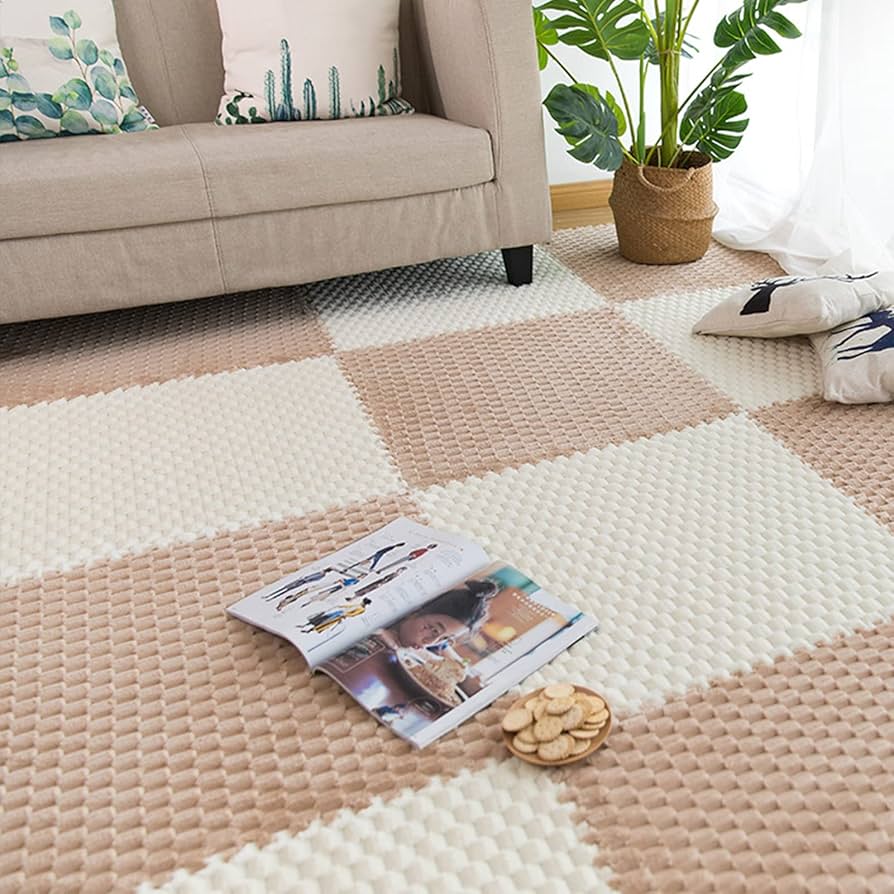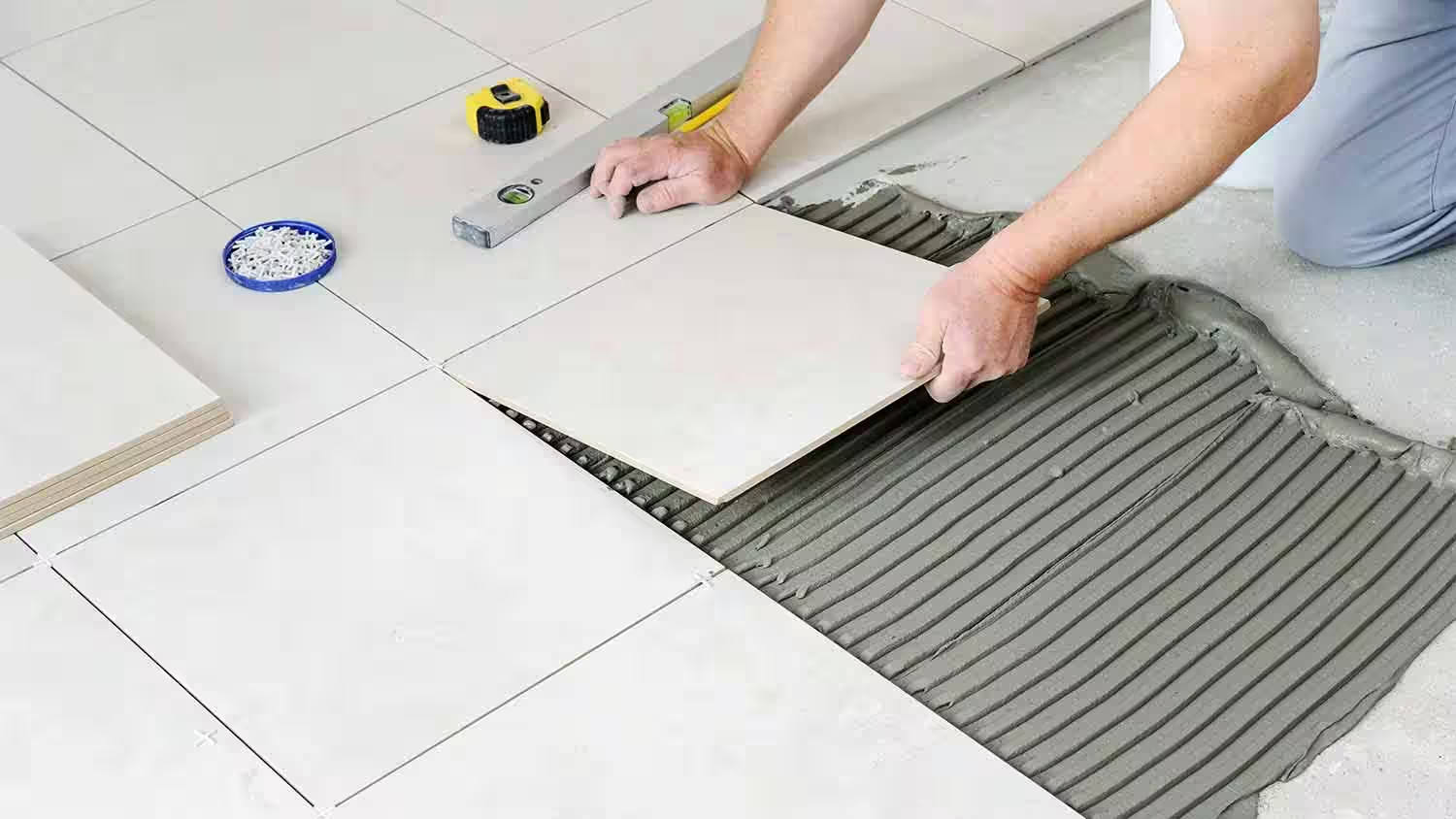
Everything You’ll Need
Tool Checklist: Ceramic vs. Porcelain Tile
| Tool / Material | Ceramic Tile | Porcelain Tile | Purpose |
|---|---|---|---|
| Tape Measure | ✔ | ✔ | Measure room size and tile gaps |
| Chalk Line | ✔ | ✔ | Mark center and guide lines |
| Straight Edge | ✔ | ✔ | Help with straight cuts and lines |
| Pry Bar | ✔ | ✔ | Take out baseboards or old floors |
| Spacers | ✔ | ✔ | Keep grout spaces even |
| Notched Trowel | ✔ | ✔ | Spread mortar on the floor |
| Mixing Paddle & Drill | ✔ | ✔ | Mix mortar and grout well |
| Wet Saw or Tile Cutter | ✔ | ✔ | Cut tiles for edges and corners |
| Utility Knife | ✔ | ✔ | Trim underlayment or score boards |
| Level | ✔ | ✔ | Make sure tiles are even |
| Grout Float | ✔ | ✔ | Push grout into joints properly |
| Bucket & Sponge | ✔ | ✔ | Clean tiles and remove grout film |
| Knee Pads | ✔ | ✔ | Protect knees while working |
| Safety Glasses | ✔ | ✔ | Shield eyes during cutting |
| Gloves | ✔ | ✔ | Protect hands from sharp tiles and mortar |
| Cement Backer Board (if needed) | ✔ | ✔ | Support tiles and resist water |
Optional (But Helpful):
| Tool / Material | Purpose |
|---|---|
| Rubber Mallet | Gently tap tiles into place |
| Tile Nippers | Make small, accurate cuts |
| Grout Sealer | Protect grout from water and stains |
Step 1: Prepare the Space
Take Off Baseboards and Old Flooring
First, remove any baseboards and old flooring to see the subfloor. This makes a smooth area for your tile to go on.
Use a pry bar to gently take off the baseboards without hurting the walls. If you are replacing carpet, laminate, or vinyl, cut them into easy pieces and clean off all glue. For old tile, use a hammer and chisel or a floor scraper to take out the tiles and mortar.
Clean the Subfloor Well
Sweep and vacuum the subfloor to get rid of all dust, dirt, and debris. A clean area helps the mortar stick well and avoids flaws in your finished floor.
Check for Damage or Moisture
Look at the subfloor for cracks, holes, or uneven spots. Use a level to find dips or high spots.
- Cracks or holes: Fill them with patching compound.
- Uneven areas: Use a floor leveling compound to make a flat, steady base.
If working over concrete, check for moisture with a moisture meter. High moisture can cause tile or grout issues, so fix any moisture problems before moving on.
Put Down Underlayment or Cement Backer Board (if needed)
Depending on your subfloor type:
- Wood subfloors: Put down cement backer board for a strong, water-resistant base.
- Concrete subfloors: Usually don’t need underlayment, but a crack isolation membrane or waterproofing membrane might be suggested sometimes.
Secure the backer board panels by following the manufacturer’s instructions, using the right screws and leaving proper gaps between panels.
Step 2: Plan Your Tile Layout
Locate Room Center and Mark Guidelines
Start by finding the room’s center. Measure the middle of each wall and use chalk lines to mark across the floor. The point where they meet is your starting spot for tiles to make sure the layout looks even.
Select Your Tile Pattern
For beginners, simple patterns are best:
- Straight Lay (Grid Pattern): Tiles line up with the walls for neat rows.
- Diagonal (Diamond Pattern): Tiles are angled at 45 degrees for a lively look — a bit more challenging but doable.
Note: Complex designs like herringbone or chevron are harder and not suggested for first-timers.
Try Tiles Without Mortar
Lay some tiles without mortar to dry-fit. This helps you:
- Check if they line up well.
- See how they fit against walls or cabinets.
- Avoid thin tile pieces at edges, which can look bad and break easily.
Tile Spacing and Grout Lines
Use spacers between tiles during dry fitting for even grout lines. Common sizes are 1/8 inch or 3/16 inch, depending on your tiles.
Estimate Tile Amount (Include 10–15% Extra)
Calculate the room’s square footage (length × width). Then:
- Multiply by 1.10 for simple layouts or 1.15 for diagonal patterns to cover cuts and possible mistakes.
- Order this amount to have enough tiles for the project.
Step 3: Choose Your Installation Method
For most tile flooring jobs—especially big ones—thinset mortar is the best way to install. It makes tiles stick well to the floor.
Common Methods:
- Thinset Mortar (Recommended)
This is a cement glue perfect for floor tiles. It holds up well against weight, water, and temperature changes. Many DIYers and pros use thinset for its strength and dependability. - Tile Adhesive (Mastic)
Best for small DIY spots or wall tiles in dry places. It’s easier to use but not strong enough for most floors or wet areas.
Note: For floor tiling, thinset is usually the top (and safest) option.
| Installation Method | Best For | Strength & Durability | DIY Friendliness | Notes |
|---|---|---|---|---|
| Thinset Mortar | Floor tiles, wet areas (bathrooms, kitchens), big spaces | ⭐⭐⭐⭐⭐ (Excellent) | Moderate | Standard for tile floors. Good for water, weight, and movement. |
| Tile Adhesive (Mastic) | Small dry areas, wall tiles | ⭐⭐ (Limited) | Easy | Not advised for floor tiles or wet places. Faster to apply but less durable. |
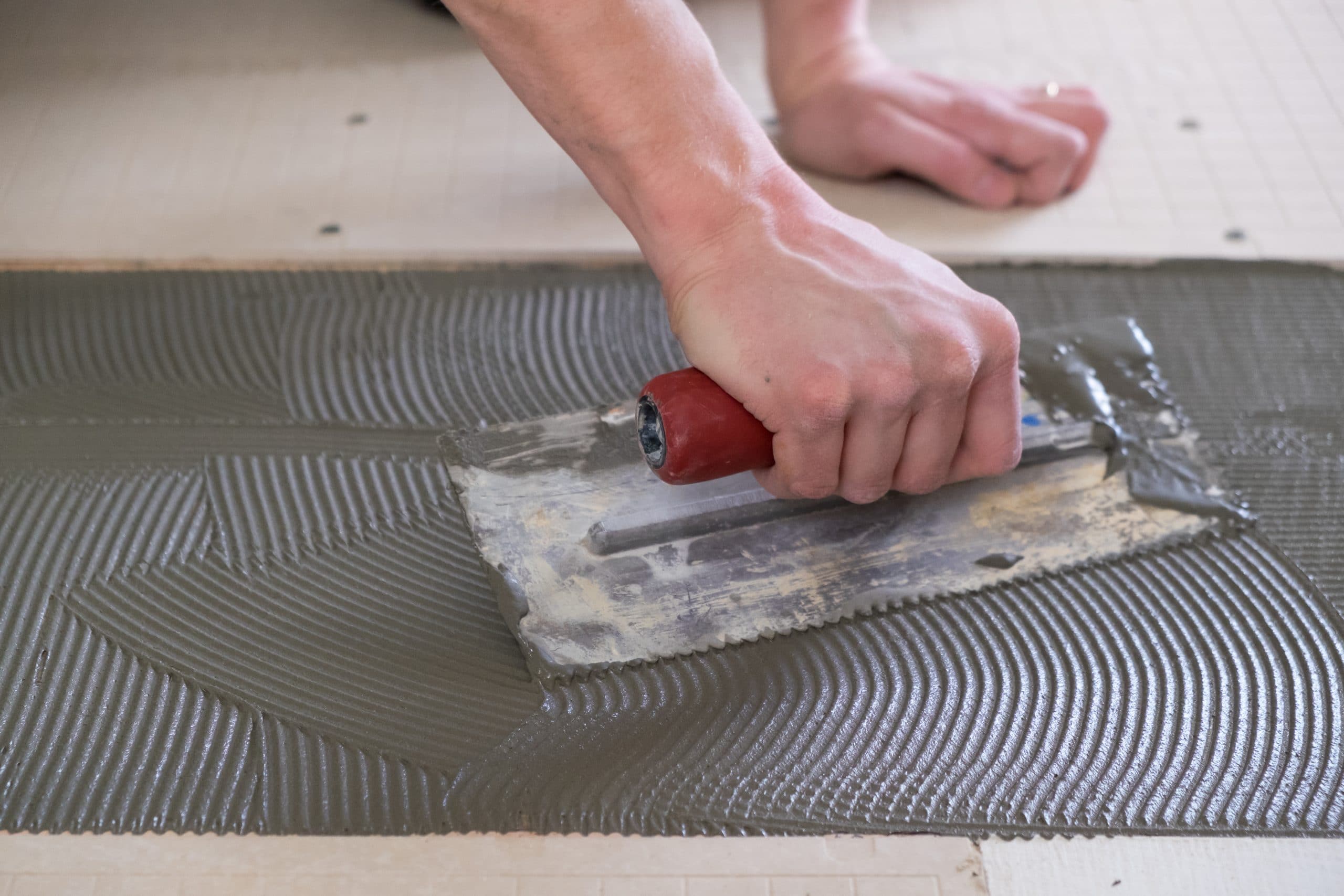
Step 4: Mix Mortar and Apply to Subfloor
Mix the Mortar
First, mix the thinset mortar as the package says. Use a clean bucket and a drill with a mixing paddle to make it smooth and without lumps. Let it sit for a few minutes, then mix again before using.
Spread the Mortar
With a notched trowel, spread the mortar over a small part of the floor. Hold the trowel at a 45-degree angle to make even ridges. These ridges help the tiles stick well and keep the floor level.
Work in Small Sections
Only spread mortar on a section you can tile in 10–15 minutes. This keeps the mortar from drying before the tiles are placed.
Pro Tip:
Put a thin layer of mortar on the back of bigger tiles for better sticking, especially if they are over 12 inches.
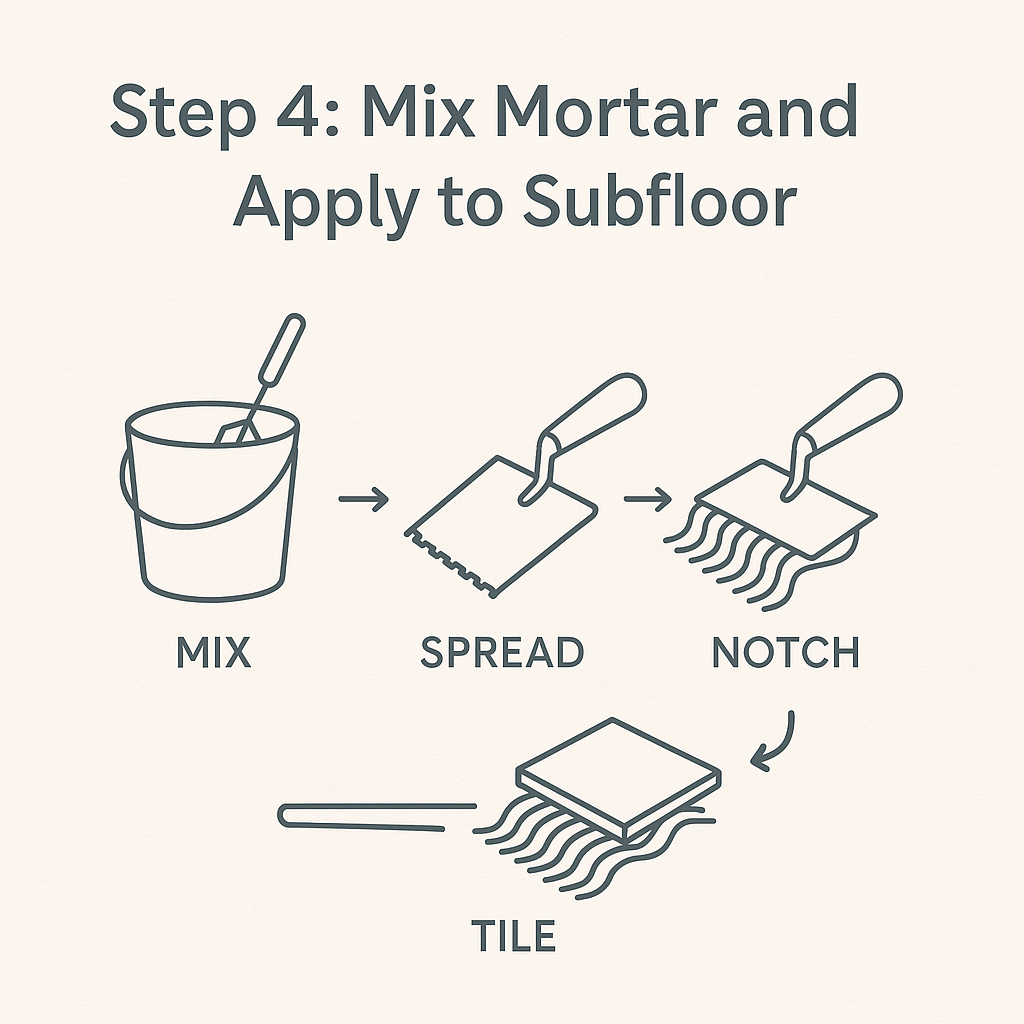
Step 5: Lay the First Tiles
Starting the right way is important for the whole project.
Begin at Your Layout Center Point
Use chalk lines from your planning to start at the center of the room or a main point. This helps spread tiles evenly.
Set the First Tile
Put the first tile into the mortar. Press firmly and twist it a bit to make it stick well.
Use Tile Spacers
Put spacers between tiles to keep gaps the same size for grout. This gives a neat, professional look.
Check for Level
After placing some tiles, use a level to check if the surface is even. Adjust if needed before the mortar dries.
Pro Tip:
Work in small areas so the mortar stays wet until tiles are placed!
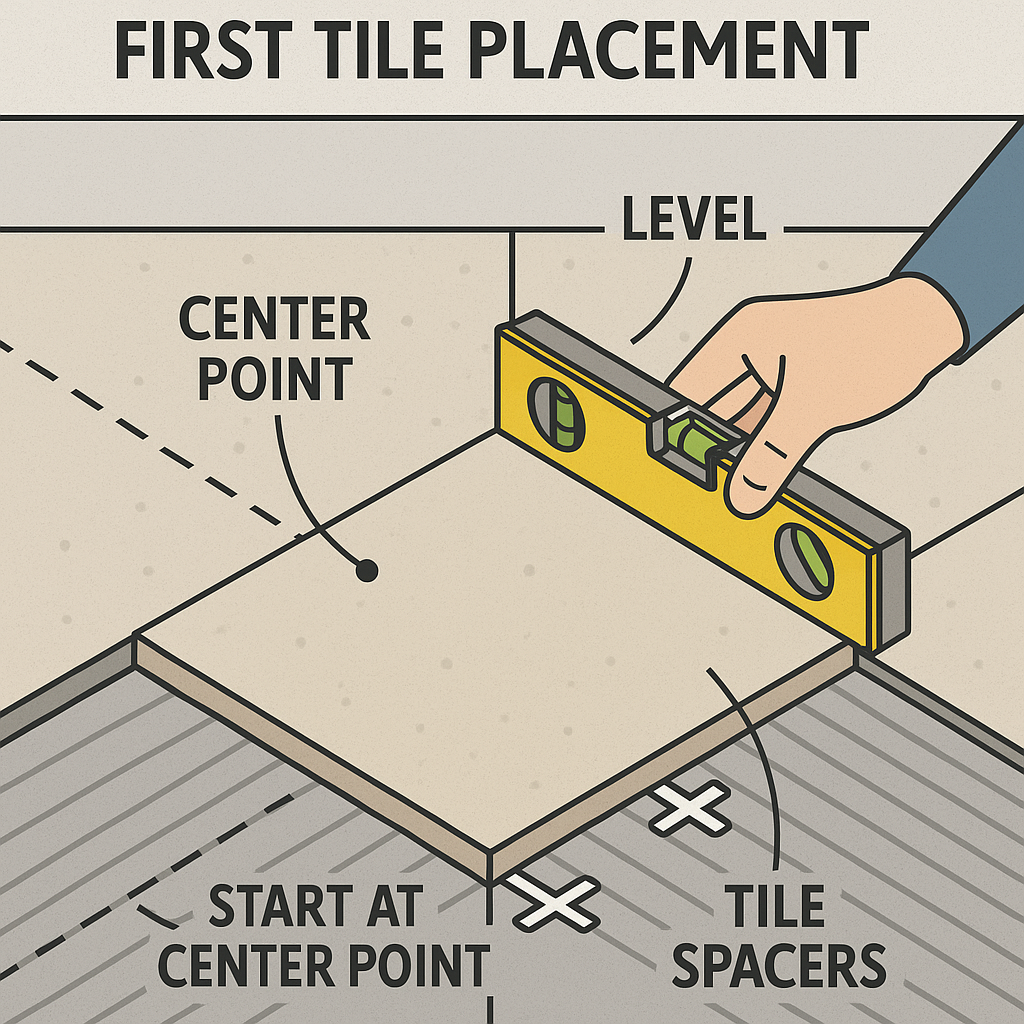
Step 6: Cutting Tiles to Fit
Accurate cutting is key for a polished, professional-looking finish.
Measure and Mark
Use a tape measure to determine the size of the tile piece you need. Mark the cutting line clearly with a pencil or wax pencil.
Choose the Right Tool
For straight cuts, a manual tile cutter works well.
For curved or intricate cuts, use a wet saw or an angle grinder with a diamond blade.
Cut in a Safe Area
Always make cuts outdoors or in a well-ventilated space to avoid dust buildup. Wear safety glasses and gloves for protection.
Pro Tip:
Measure twice before cutting to reduce waste and ensure a perfect fit!
Step 7: Install Remaining Tiles and Let Mortar Cure
Once the first tiles are set, continue laying the remaining tiles row by row. Work outward from your starting point, placing each tile carefully with spacers to maintain uniform grout lines. Regularly check that tiles are level and adjust as needed to prevent uneven surfaces.
As you progress, avoid walking on newly set tiles to prevent shifting. Work in manageable sections to ensure the mortar doesn’t dry out before tiles are placed.
After all tiles are installed, allow the mortar to cure for at least 24 hours (or as recommended by the manufacturer) before proceeding to grout. Proper curing is essential for a durable and long-lasting tile floor.
Step 8: Apply Grout
Once the mortar has fully cured, it’s time to grout the joints between the tiles:
Mix the Grout
Follow the manufacturer’s instructions to mix the grout to a smooth, peanut butter-like consistency.Spread Grout Using a Float
Use a rubber grout float held at a 45° angle to spread the grout across the tile surface. Press firmly to ensure the grout fills all the joints completely.Remove Excess Grout
After filling the joints, hold the float at a steep angle and scrape away excess grout from the tile surfaces.Clean the Tiles with a Damp Sponge
Wait about 10 to 15 minutes, then use a damp sponge to gently wipe the tile surfaces clean. Rinse the sponge frequently and avoid removing grout from the joints.Final Buffing
Once the grout begins to haze on the tile (after another 30–60 minutes), use a dry microfiber cloth to buff the surface and remove any remaining haze.
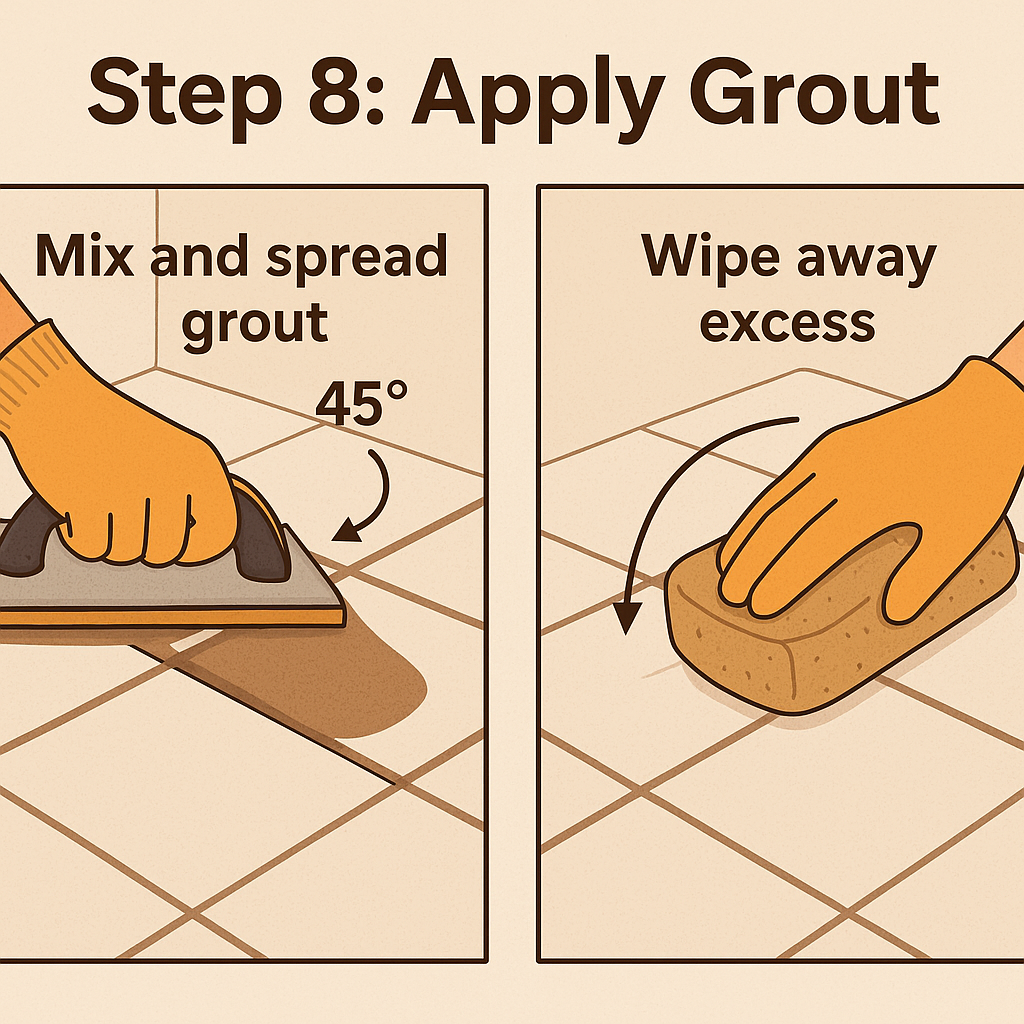
Step 9: Clean and Seal the Floor
Remove Grout Haze
After the grout has dried (usually 24 to 48 hours), a hazy residue will appear on the tile surfaces. Use a damp sponge or specialized grout haze remover to gently clean the tiles. Be careful not to disturb the grout lines.
Apply Grout Sealer
If recommended by the grout manufacturer, apply a grout sealer to protect the grout from moisture, stains, and mold. Use a small applicator brush or a sealer bottle with a roller tip for precision. Allow the sealer to cure fully according to the product instructions.
Reinstall Baseboards and Transition Strips
Once everything is clean and dry, reinstall your baseboards and add any necessary transition strips between different flooring types or rooms. This gives your new tile floor a polished, professional finish.
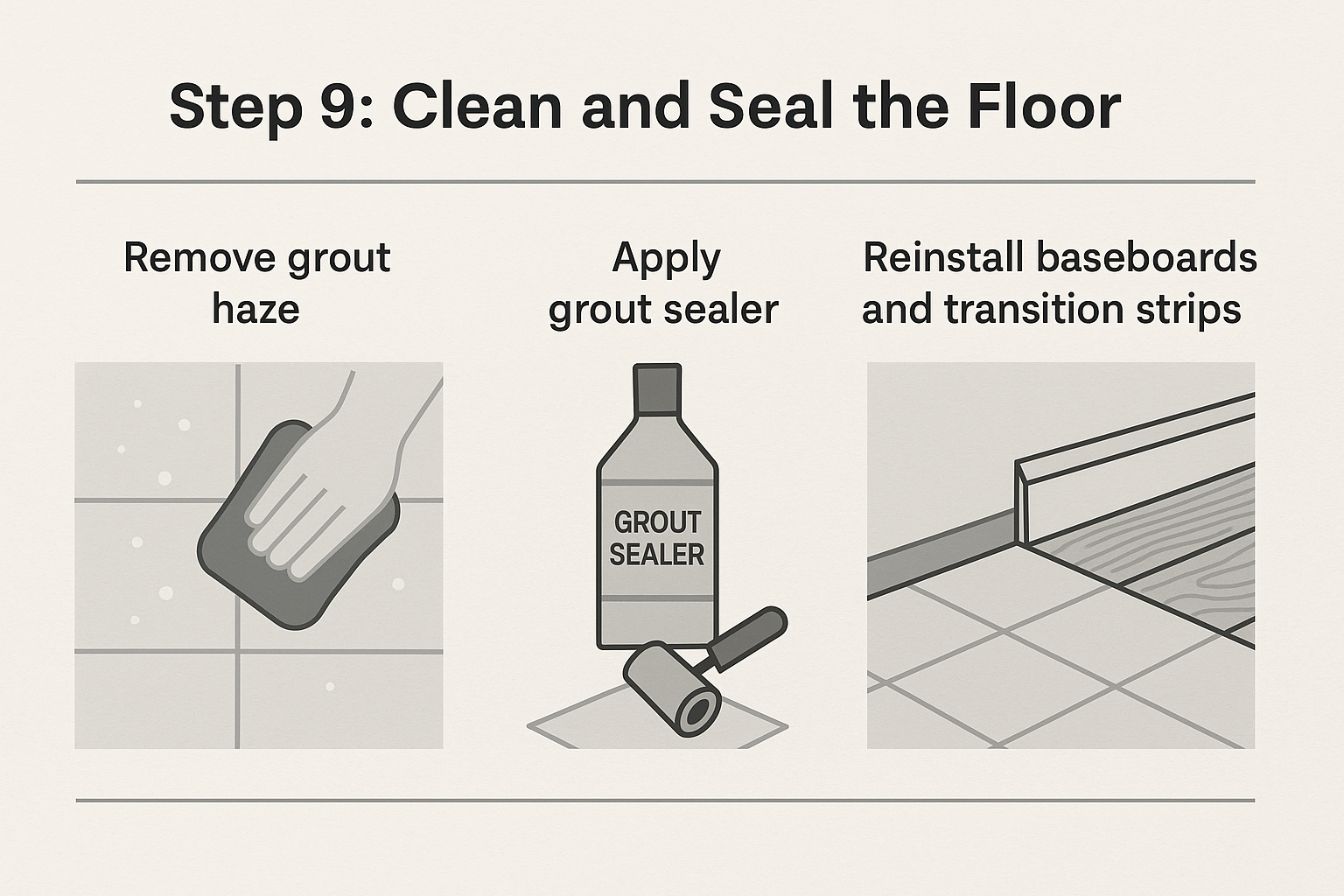
DIY vs. Professional Tile Installation
While installing tile flooring yourself can save money, it’s not always the right choice for every project. Here’s how to decide if DIY or hiring a pro is best for you.
DIY Pros
- Lower upfront cost
- Flexibility to work at your own pace
- Great for small, simple rooms (bathrooms, laundry rooms)
DIY Cons
- Requires time, precision, and specialized tools
- Mistakes can lead to costly repairs
- Challenging for complex layouts or large spaces
Professional Installation Pros
- Expert precision and long-lasting results
- Faster completion, especially for large areas
- Includes subfloor preparation, cutting, and cleanup
- Warranties often included
Professional Installation Cons
- Higher upfront cost
- Less control over timeline
Cost Comparison
Here’s what you can typically expect to pay:
| Installation Type | Average Cost per Sq Ft | Typical Total for 250 Sq Ft |
|---|---|---|
| DIY Installation | $2 – $8 (materials + rental tools) | $500 – $2,000 |
| Professional Installation | $8 – $25 | $2,000 – $6,250 |
👉 For a full breakdown, check out our Tile Flooring Cost Guide.
Pro Tips for a Successful Tile Flooring Installation
Want to get pro-level results from your DIY tile project? Keep these tips in mind:
- Save time by organizing tools and tiles before starting. Lay out tiles and tools within easy reach.
- Use a high-quality wet saw for clean, precise cuts — especially for porcelain tiles.
- Mix small batches of mortar and grout. This prevents drying out before use.
- Check for level frequently with a spirit level as you lay tiles.
- Work in small sections. This ensures the mortar doesn’t dry before you place the tiles.
- Minimize breakage. Always cut tiles slowly and wear safety glasses.
Common Mistakes to Avoid When Installing Tile Flooring
Even experienced DIYers can make these common errors:
- Skipping subfloor leveling. An uneven subfloor can cause cracked tiles and uneven lines.
- Forgetting spacers. Inconsistent grout lines lead to an unprofessional look.
- Walking on tiles before the mortar cures. This can shift tiles and ruin alignment.
- Using too much or too little mortar. This can cause poor adhesion or tiles sitting unevenly.
- Not cleaning grout haze promptly. Leaving grout haze too long can make it very hard to remove.
Do You Need Professional Help With Your Tile Flooring Installation Project?
Now that you’ve learned how to install tile flooring step-by-step, you’re well on your way to creating a strong, beautiful surface that can last for decades. But if you’d rather leave the precision work — like leveling, cutting, and grouting — to the pros, we’re here to help.
Our expert flooring installation team can handle every detail for you — from prepping the subfloor to carefully laying and sealing each tile — ensuring a flawless, long-lasting result. We’ll also help you select the right tile style and materials for your space and budget.
Contact us today to schedule your free in-home consultation and find out if we serve your area!



